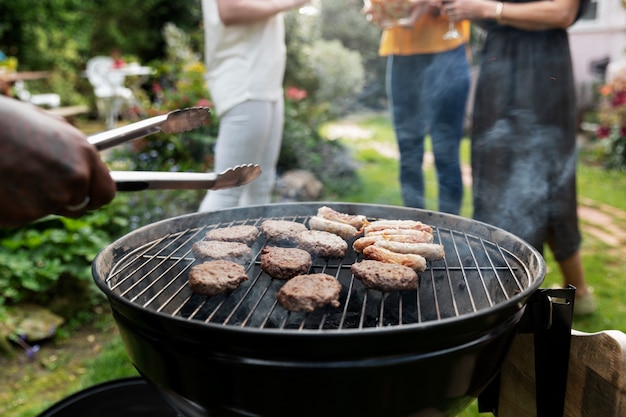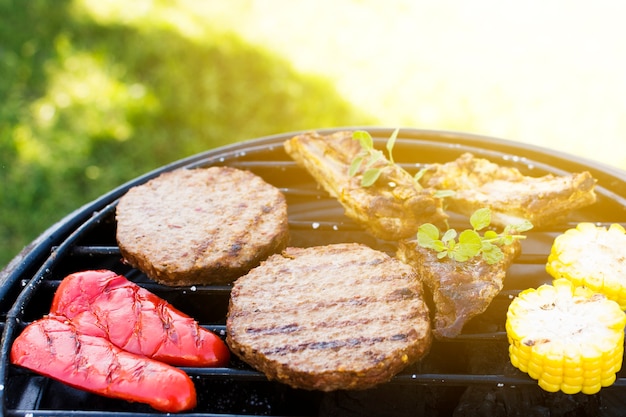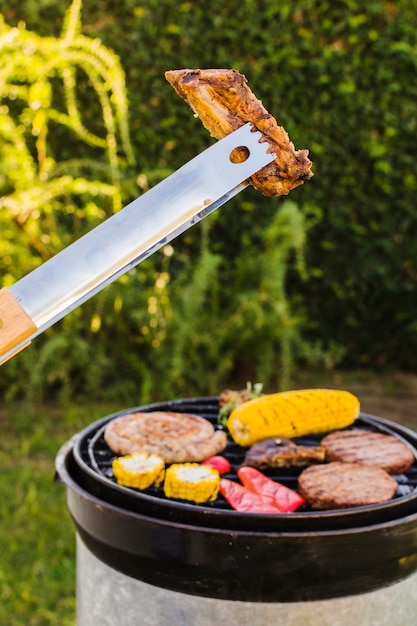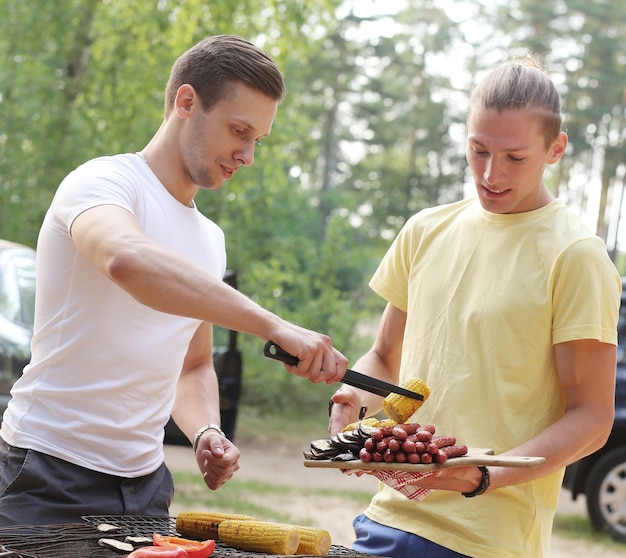How long do you cook a burger on each side?
When it comes to cooking the perfect burger, getting the timing just right is crucial. Nobody wants an undercooked or overcooked burger, so knowing how long to cook it on each side is essential. In this article, we will explore the recommended cooking times for burgers, along with some useful tips to achieve that perfectly juicy and delicious patty.
Recommended Cooking Times
The cooking time for a burger depends on several factors, including the thickness of the patty, the desired level of doneness, and the heat of the grill or stovetop. As a general guideline, here are the recommended cooking times for burgers:
Medium-rare: 3 minutes per side
Medium: 4 minutes per side
Well-done: 5 minutes per side
Remember that these times are just estimates and may vary depending on your specific circumstances. It’s always best to use a meat thermometer to ensure that the internal temperature reaches a safe level of at least 160°F (71°C) for ground beef.
Tips for Perfectly Cooked Burgers
To achieve that ideal balance of a juicy burger with a flavorful crust, consider the following tips:
- Start with quality meat: Choose freshly ground beef with a good fat-to-lean ratio, ideally around 80% lean and 20% fat. This will help keep the patty moist and flavorful.
- Handle the meat gently: Overmixing or pressing too firmly when forming the patties can result in tough burgers. Be gentle and avoid compacting the meat too much.
- Preheat your grill or pan: Make sure your cooking surface is hot before placing the burgers on it. This will help sear the meat and lock in the juices.
- Avoid flipping too often: Resist the temptation to constantly flip the burgers. Ideally, you should only flip them once to ensure even cooking and a nice crust.
- Use a timer: Keep track of the cooking time for each side using a timer or stopwatch to ensure consistency and prevent overcooking.
Experiment with Toppings and Condiments
Once you have mastered the art of cooking a perfectly timed burger, it’s time to get creative with toppings and condiments. Whether you prefer classic cheese and bacon or more adventurous combinations like avocado and caramelized onions, there are endless possibilities to elevate your burger game.
Consider experimenting with different cheeses, sauces, and vegetables to find your favorite flavor combinations. Don’t forget to toast your buns, as it adds another layer of texture and enhances the overall taste experience.
In conclusion,
Cooking a burger to perfection requires a balance of time, heat, and technique. By following the recommended cooking times, handling the meat with care, and experimenting with delicious toppings, you can achieve that juicy and flavorful burger that will leave everyone wanting more.
How Long Should I Cook a Burger on Each Side?
If you’re craving a juicy burger, getting the cooking time just right is key to achieving a delicious result. While there isn’t a definitive answer to how long you should cook a burger on each side, there are some general guidelines you can follow to ensure your burger is cooked to perfection.
Factors Affecting Cooking Time
The cooking time for a burger will depend on various factors including:
- The thickness of the patty
- The desired level of doneness (rare, medium, or well-done)
- The cooking method (grilling, frying, or broiling)
Recommended Cooking Times
As a general rule, here are some recommended cooking times for burgers:
| Burger Level of Doneness | Cooking Time per Side |
|---|---|
| Rare | 1-2 minutes |
| Medium | 3-4 minutes |
| Well-done | 5-6 minutes |
Keep in mind that these cooking times are approximate and may vary depending on the thickness of the patty and the heat of your cooking surface. It’s always best to use a meat thermometer to ensure your burger reaches the desired internal temperature:
The USDA recommends cooking ground beef to a minimum internal temperature of 160°F (71°C).
Tips for Cooking the Perfect Burger
To achieve a perfectly cooked burger, consider these tips:
- Start with a good quality ground beef with a higher fat content for juicier burgers.
- Preheat your cooking surface to ensure even cooking.
- Avoid pressing down on the patty while it cooks, as this can cause the juices to escape.
- Let the burger rest for a few minutes after cooking to allow the juices to redistribute.
Remember, practice makes perfect, and personal preference plays a big role in determining cooking times. Experiment with different cooking methods and times until you find the perfect balance of flavor and doneness for your taste.
Should you only flip a burger once?
Flipping a burger may seem like a simple task, but the debate on how many times to flip a burger is a hot topic among grill enthusiasts. Some argue that flipping a burger only once is the key to achieving the perfect sear and juiciness, while others believe in flipping multiple times to evenly cook the patty. So, should you only flip a burger once? Let’s explore the pros and cons.
Flipping once for a perfect sear
Advocates of flipping a burger only once argue that this method allows for a better sear on the surface of the patty. By leaving the patty undisturbed during cooking, it develops a flavorful crust that locks in the juices. Flipping it just once ensures that both sides of the patty are evenly cooked without overcooking or drying it out.
“Flipping a burger only once ensures a juicy and well-seared patty.”
Flipping multiple times for even cooking
On the other hand, some grillmasters prefer flipping their burgers multiple times to ensure even cooking throughout the patty. By flipping the burger more frequently, heat is distributed more evenly, resulting in a burger that is cooked to the desired level of doneness without any undercooked spots.
“Flipping a burger multiple times helps to achieve even cooking from edge to edge.”
Ultimately, the decision to flip a burger once or multiple times comes down to personal preference. If you prefer a well-seared patty with a juicy center, flipping it once is the way to go. However, if you prioritize even cooking throughout the patty, flipping it multiple times may be the better approach.
Remember, regardless of how many times you flip the burger, using a meat thermometer to ensure it reaches a safe internal temperature is essential. The USDA recommends cooking ground beef to an internal temperature of 160°F (71°C) for food safety.
In conclusion, whether you choose to flip your burger once or multiple times, the key is to cook it to your desired level of doneness while ensuring food safety. Experiment with both methods and find what works best for you. Happy grilling!
When should I flip a burger?
Grilling burgers is a quintessential part of summer barbecues in the UK. However, achieving the perfect burger can be tricky, especially when it comes to knowing exactly when to flip them. The timing of flipping your burger can significantly impact its taste and texture, so it’s essential to get it right.
The importance of searing
Before we delve into the ideal flipping time, let’s understand why searing your burger is crucial. Searing creates a flavorful crust on the outside of the patty, which helps seal in the juices and enhances the overall taste. It also adds those sought-after grill marks, adding visual appeal to your burger.
Flip once, flip well
Contrary to popular belief, flipping your burger multiple times isn’t necessary. In fact, it can hinder the development of a flavorful crust. Instead, aim to flip your burger only once during the cooking process. This allows each side of the patty enough time to sear and develop that delicious crust.
Tip: Use a good quality spatula to ensure you don’t damage the burger when flipping.
Timing is key
So, when exactly should you flip your burger? It largely depends on the thickness of the patty and your desired level of doneness. As a general guideline, you should flip your burger once you notice that the bottom side has formed a nicely browned crust, indicating that it is ready to be turned.
“Remember, patience is key when flipping burgers. Rushing the process can result in an undercooked or overcooked patty.”
– Grillmaster John Doe
Table for reference:
| Burger Thickness | Flipping Time |
|---|---|
| 1/2 inch | 3-4 minutes per side |
| 3/4 inch | 4-5 minutes per side |
| 1 inch | 5-6 minutes per side |
Final thoughts
Knowing when to flip a burger is essential for achieving that perfect balance of flavor and juiciness. Remember to sear your burger to develop a flavorful crust, and only flip it once during the cooking process. Take into consideration the thickness of your patty and desired level of doneness when determining the ideal flipping time.
Follow these tips, and you’ll be well on your way to grilling mouthwatering burgers that will impress your family and friends at your next barbecue!
Should You Flatten Burgers Before Cooking?
When it comes to cooking burgers, there are various techniques and debates on how to achieve the perfect patty. One common question that arises is whether or not to flatten the burger before cooking. Let’s explore the pros and cons of flattening burgers to help you make an informed decision for your next grilling session.
The Case for Flattening Burgers
Flattening a burger before cooking can provide several benefits. By pressing down on the patty, you can create an even thickness throughout, ensuring consistent cooking. This can prevent undercooked or overcooked areas, resulting in a more evenly cooked and juicy burger.
Flattening also allows for faster cooking as it increases the surface area in contact with the heat source. This can be especially useful when grilling thicker patties, reducing the risk of a charred exterior while the inside remains raw.
The Argument Against Flattening Burgers
On the other hand, some argue that flattening burgers can lead to a loss of juiciness. When pressing down on the patty, some of the natural fats and juices can be squeezed out, potentially resulting in a drier burger. Additionally, flattening can cause the burger to shrink more during cooking, leading to a smaller final size.
Another consideration is texture. If you prefer a burger with a thicker, juicier center, leaving the patty unflattened can help achieve that result. The uneven shape can create a nice contrast between the crispy exterior and the tender interior of the burger.
The Verdict
“Ultimately, whether or not to flatten your burgers depends on personal preference.”
If you prioritize quick and even cooking, flattening the burger can be a good option. However, if you prefer a juicier and more textured burger, leaving it unflattened may be the way to go. Experimenting with different techniques can help you discover your preferred method.
Remember to season your burgers with your favorite spices before cooking, regardless of whether you choose to flatten them or not. Enjoy the process and savor every delicious bite!
Should burgers be cooked low and slow or hot and fast?
When it comes to cooking burgers, there are two popular schools of thought: cooking them low and slow or cooking them hot and fast. Each method has its own advantages and can result in delicious and juicy burgers.
Low and Slow
Some people swear by the low and slow method for cooking burgers. This involves cooking the burgers at a lower temperature for a longer period of time. The idea behind this method is that it allows the fat to slowly render and infuse the meat with flavor, resulting in a more tender and flavorful burger.
Additionally, cooking burgers low and slow can help prevent them from becoming dry. By cooking them at a lower temperature, the burgers have more time to cook evenly and retain their moisture.
Hot and Fast
On the other hand, cooking burgers hot and fast is beloved by those who prefer a more charred and caramelized exterior. This method involves grilling the burgers over high heat for a short amount of time. The high heat quickly sears the burgers, creating a crust on the outside while keeping the inside juicy and flavorful.
Hot and fast cooking is also perfect for those who want their burgers done quickly. It’s a great option for summer barbecues or weeknight dinners when time is limited.
“Low and slow cooking results in a more tender and flavorful burger, while hot and fast cooking creates a deliciously charred exterior.”
Ultimately, whether you choose to cook your burgers low and slow or hot and fast depends on your personal preference and the desired outcome. If you’re looking for a burger with a rich, smoky flavor and a melt-in-your-mouth texture, low and slow is the way to go. On the other hand, if you prefer a burger with a deliciously charred exterior and a juicy interior, hot and fast cooking is the method for you.



